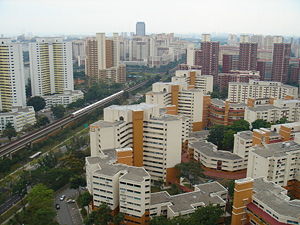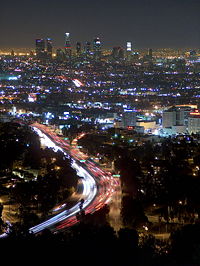Urbanization
Urbanization is the increase over time in the population of cities in relation to the region's rural population. Urbanization is studied in terms of its effects on the ecology and economy of a region, while the discipline of urban sociology studies political, psychological, and anthropological changes to human society that occur in an urban environment.
Definition
Urbanization is the growing number of people in a society living in urban areas, such as cities. Urbanization groups many people in a central location, different from suburban or rural areas in their population distribution and the development of businesses. Urban areas tend to attract businesses because of their large and dense population. This in turn draws more people to the area, working in a kind of circular process.
Urbanization means increased spatial scale and/or density of settlement and/or business and other activities in the area over time. This typically involves the transformation of peripheral population from rural to urban, together with the settlement of incoming migrants. Urbanization could occur as a result of natural expansion of the existing population, however most commonly it results from a large influx of people from outside.
Economic effects
The most striking immediate change accompanying urbanization is the rapid change in the prevailing character of local areas. As agriculture, more traditional local services, and small-scale industry give way to modern industry the urban and related commerce with the city drawing on the resources of an ever-widening area for its own sustenance and goods to be traded or processed into manufactures.
Research in urban ecology has found that larger cities provide more specialized goods and services to the local market and surrounding areas, function as a transportation and wholesale hub for smaller places, and accumulate more capital, financial service provision, and an educated labor force, as well as often concentrating administrative functions for the area in which they lie. This relation among places of different sizes is called the urban hierarchy.
As cities develop, effects can include a dramatic increase in rents, often pricing the local working class out of the market, including such functionaries as employees of the local municipalities:
Urban development in our period [1789–1848] was a gigantic process of class segregation, which pushed the new labouring poor into great morasses of misery outside the centres of government and business and the newly specialised residential areas of the bourgeoisie. The almost universal European division into a 'good' west end and a 'poor' east end of large cities developed in this period.[1]
This separation of the quality of housing into east and west sides is likely due the prevailing south-west wind, which carried coal smoke and other airborne pollutants downwind, making the western sides of towns preferable to the eastern ones.
Suburbanization
Traditional urbanization exhibits a concentration of human activities and settlements around the downtown area. When the residential area shifts outward, this is called suburbanization. A number of researchers and writers suggest that suburbanization has gone so far as to form new points of concentration outside the downtown. This networked, poly-centric form of concentration may be considered an emerging pattern of urbanization. Los Angeles is the best-known example of this type of urbanization.
History
Around two thousand years ago, the world had less than two hundred fifty thousand people, and cities exceeding over twenty thousand citizens were rare. Cities ranged from two thousand to twenty thousand up until the sixteenth century, when cities with populations climbing to and exceeding one hundred thousand began to spring up. From 1800 to 2000, the population climbed to six times its size, greatly increasing the numbers of urban inhabitants. In 1900, only a handful of cities had populations over one million. At the beginning of the twenty-first century, roughly half of the world's population lived in urban areas, with the number of cities of over one million inhabitants increased many times over compared to 1900.[2]
Cities emerged from villages due to improvement in the cultivation, transportation, and the preservation of food and other resources. The rise of the city broke down a mechanical way of life and led to an organic society: cities were not closed to outsiders, and often, many different types of people with new ideologies inhabited cities. Different processes led to the acceptance of the city over the village. Cities developed an organized social core, where the entire community centered itself; villages often lacked this cohesiveness.
However, a city often breaks the bonds human beings have with nature—in a city, one is surrounded by man-made structures and technologies, and the former connection with nature as a provider is severed. These processes are detailed in different stages of urbanization.
The first stage of urbanization was dependent upon the amount and productivity of the available agricultural land. Population increases had to be limited—more people could mean less resources. The second stage of urbanization was the development of sea-river transports and the creation of roads. This built on the first stage, but because trade and industry were developed, populations were no longer limited in their growth. The third stage, which is still currently in progress, is the shift in the economy to technological advances and population growth. This stage is set for an indeterminate amount of time, and is proving to change the interaction between urban dwellers and cities.[3]
Urbanization Today
The 2005 Revision of the UN World Urbanization Prospects report described the twentieth century as witnessing "the rapid urbanization of the world’s population," as the global proportion of urban population rose dramatically from 13 percent (220 million) in 1900, to 29 percent (732 million) in 1950, to 49 percent (3.2 billion) in 2005. The same report projected that the figure was likely to rise to 60 percent (4.9 billion) by 2030.[4]
Urbanization Projections
According to the UN-HABITAT 2006 Annual Report, sometime in the middle of 2007, the majority of people worldwide will be living in towns or cities for the first time in history; this is referred to as the arrival of the "Urban Millennium." In regard to future trends, it is estimated 93 percent of urban growth will occur in Asia and Africa, and to a lesser extent in Latin America and the Caribbean. By 2050 over 6 billion people, two thirds of humanity, have been projected to be living in towns and cities.
Internet and Urbanization
The creation of the internet has impacted the way that people interact, work, and spend their leisure time. Office work and data entry is becoming dominated by internet protocol and programs, and so it is not uncommon to find employees working from their homes. This is seen as ideal for many—the prospect of being able to work from the comfort of home while completing the same duties as one would at an office is a desirable work environment. This area of work has come to be known as telecommuting or E-Work.
The idea of telecommuting is to replace the commute to a work or business by the transfer of information from a computer to another computer—it brings the work to the worker. As well as being convenient for workers, this system has many beneficial results on society as a whole. For one, it cuts back on traffic congestion, since fewer commuters have to travel to work on a daily basis. This also decreases the amount of pollution in the city's air. A healthier environment benefits every person living in the area, increases the attractiveness of the city, and improves the quality of life for the population.[5]
Examples of Urbanization
Urbanization rates vary across the globe. The United States and United Kingdom have a far higher urbanization level than China, India, Swaziland, or Nigeria. Their annual urbanization rates are far slower, however, since a much smaller proportion of the population is still living in a rural area and in the process of moving to cities. Areas that have been affected by urbanization in these countries in more recent times include:
- Urbanization in the United States has affected the Rocky Mountains in locations such as Jackson Hole, Wyoming, Telluride, Colorado, Taos, New Mexico, Douglas County, Colorado and Aspen, Colorado. The lake district of northern Minnesota has also been affected as has Vermont, the coast of Florida, the Birmingham-Jefferson County, Alabama area, and the Barrier Islands of North Carolina.
- In the United Kingdom, two major examples of new urbanization can be seen in Swindon, Wiltshire and Milton Keynes, Buckinghamshire. These two towns show some of the quickest growth rates in Europe.
Seoul, South Korea
Few cities have seen such a rapid population growth as Seoul in South Korea. Starting at a population of 900,000 in 1945, the population rose to over ten million by 1990.[6] This urbanization boom brought increased revenue and economic prosperity for the city, but it also created new kinds of problems. Incineration plants and garbage dumps were constructed without consulting local residents, leading to angry residents and their migration from the area. Transportation systems have not been easy to coordinate, as competing transit systems have different bus routes and time tables. Construction also has played a role, as physically expanding a city requires heavy construction, which creates traffic congestion. The government of Seoul has found it essential to work closely with local authorities and citizens to manage these issues.[7]
Africa
At the turn of the nineteenth century, Africa south of the Sahara had a total urban population of less than five percent, most opting for more traditional agricultural jobs. By 2000, the number of urban inhabitants reached nearly thirty-eight percent, with an expected jump to over forty-five percent by 2015.[8] The growth of urbanization in Africa is slow, but it is steady.
Predictions regarding Africa's urbanization have been inaccurate, however, and this is partially due to the AIDS epidemic, unexpected government coups, and wars between nations. Times of war have seen a strong rural-urban population flux. Nevertheless, the Nigerian city of Lagos which, in 1963, had 665,000 residents,[9] jumped to nearly nine million residents in 2000, and is expected to reach sixteen million residents by 2015, making it the eleventh largest city in the world. Urbanization is happening in Africa, just slower than originally anticipated.
Planning for urbanization

Urbanization can be planned or organic. Unplanned (organic) cities are the oldest form of urbanization. Examples can be seen in many ancient cities; although with exploration came the collision of nations, which meant that many invaded cites took on the desired planned characteristics of their occupiers. Many ancient organic cities experienced redevelopment for military and economic purposes, new roads carved through the cities, and new parcels of land were cordoned off serving various planned purposes giving cities distinctive geometric designs.
Planned urbanization, such as New Urbanism and the Garden City Movement, is based on an advance plan, which can be prepared for military, aesthetic, economic or urban design reasons. Generally, it is preferable to install urban infrastructure before urbanization occurs. landscape planners are responsible for landscape infrastructure (such as public parks, sustainable urban drainage systems, greenways) which can be planned before urbanization takes place, or afterward to revitalize an area and create a more pleasant living environment within a region.
Garden City Movement

The Garden City Movement is an approach to urban planning that was founded in 1898 by Ebenezer Howard in England. Garden cities were to be planned, self-contained communities surrounded by greenbelts, and containing carefully balanced areas of residences, industry, and agriculture.
Inspired by Edward Bellamy's Utopian novel Looking Backward, Howard organized the Garden City Association and founded two cities in England: Letchworth Garden City in 1903, and Welwyn Garden City in 1920. Both designs are durable successes and healthy communities today, although not a complete realization of Howard's ideals.
The idea of the garden city was influential in the United States (in Pittsburgh's Chatham Village; Sunnyside, Queens; Radburn, New Jersey; Jackson Heights, Queens; the Woodbourne neighborhood of Boston; Garden City, New York; and Baldwin Hills Village in [[Los Angeles) and in Canada in (Walkerville, Ontario). The first German garden city, Hellerau, a suburb of Dresden, was founded in 1909. The concept was drawn upon for German worker housing built during the Weimar years, and again in England after World War II when the New Towns Act triggered the development of many new communities based on Howard's egalitarian vision. The garden city movement also influenced the British urbanist Sir Patrick Geddes in the planning of Tel-Aviv, Israel. Contemporary town planning charters like New Urbanism and Principles of Intelligent Urbanism find their origins in this movement.
American New Urbanism
New Urbanism was a movement in Urban Design which started in the late 1980s in the United States. The idea is to shift design focus from the car-centric development of suburbia and the business park, to concentrated pedestrian and transit-centric, walkable, mixed-use communities. New Urbanism is an amalgamation of old-world design patterns merged with present day demands. It is a backlash to the age of suburban sprawl, which splintered communities, and isolated people from each other, as well as had severe environmental impacts. Concepts for New Urbanism include bringing people and destinations into dense, vibrant communities, and decreasing dependency on vehicular transportation as the primary mode of transit.
European New Urbanism
The European Urban Renaissance, a movement stemming from American New Urbanism, was unveiled in 1996. Many of the criteria for urbanism in Europe included revitalizing the city garden, healing the city, founding new traditional cities, urbanizing the suburbs, and constructing new traditional public buildings. The success of urbanism projects in Europe has led to new projects throughout the continent, some of which include re-inventing major cities to the standards of new urbanism.
Conclusions
Urbanization has led to the revitalization of the city and the focus on its population's quality of life. The realization of environmental dangers has led to city planning that de-emphasize the automobile and encourage walking, car pooling, or public transportation as a method to cut down on pollution. Urbanization, especially in the New Urbanism movement, shows that city architecture and construction can be a display of art, not just functional buildings. With this rise in urban artistic expression comes a greater cultural pride for living in the city. The city life becomes more attractive through urbanism; it no longer looks overpopulated, crowded, and stifling. Urbanism creates a new way to look at city life, while bringing in new businesses and people. As these new businesses create new jobs the city becomes an economic capital, generating commerce and prosperity for the increasing urban population.
Urbanization, without clear attempts to adapt the city to the population increase, is detrimental to the city's survival. Traffic congestion, increased pollution, limited real estate, and decreasing resources are all possible side effects for urbanization if it is not properly addressed. Urbanization has been the trend of many countries for the past century, and this trend seems to be growing with few signs of slowing down.
Notes
- ↑ Eric Hobsbawm, The Age of the Revolution: 1789–1848 (Peter Smith Publishers 1999 ISBN 084466992X)
- ↑ "History of Urbanization" Encyclopedia Britannica Online (2007). Retrieved May 13, 2007.
- ↑ Lewis Mumford, The Natural History of Urbanization, (Chicago 1956). Retrieved May 13, 2007.
- ↑ World Urbanization Prospects: The 2005 Revision, Population Division, Department of Economic and Social Affairs, UN. Retrieved May 13, 2007.
- ↑ Kathy Daniel, CMAQ and Telecommute Programs (U.S. Department of Transportation 2005). Retrieved May 13, 2007.
- ↑ Vernon Henderson, "Urbanization in Developing Countries." The World Bank Research Observer (2002). Retrieved May 13, 2007.
- ↑ Chan Gon Kim, Urban and Metropolitan Management of Seoul: Past and Present (Policy Planning Bureau 2000). Retrieved May 13, 2007.
- ↑ United Nations, Population Division 2003: World Population Prospects. (New York 2002).
- ↑ Carole Rakodi, The Urban Challenge in Africa: Growth and Management of its Large Cities (New York: United Nations University, 1996).
ReferencesISBN links support NWE through referral fees
- Champion, A. G., Graeme Hugo, and Tony Champion (Eds). 2003. New Forms of Urbanization: Beyond the Urban-Rural Dichotomy. Ashgate Publishing. ISBN 0754635880
- Connell, John. 2001. Urbanization of the Pacific. Routledge. ISBN 0415246709
- Correa, Charles. 2000. Housing and Urbanization: Building Solutions for People and Cities. Thames and Hudson. ISBN 0500282102
- De Vries, Jan. 1984. European Urbanization: 1500-1800. Harvard University Press. ISBN 0674270150
- Dutt, A.K., A.G. Noble, G. Venugopal, and S. Subbiah (Eds). 2003. Challenges to Asian Urbanization in the 21st Century. Springer. ISBN 1402015763
- Falola, Toyin and Steven J. Salm. 2005. Urbanization and African Cultures. Caroline Academic Press. ISBN 0890895589
- Keil, Roger. 1998. Los Angeles: Globalization, Urbanization, and Social Struggles. Academic Press. ISBN 0471983527
- Osborne, Robin and Barry Cunliffe (Eds). 2007. Mediterranean Urbanization 800-600 B.C.E.. British Academy. ISBN 978-0197263259
- Rakodi, Carole. 1996. The Urban Challenge in Africa: Growth and Management of Its Large Cities (Mega-city). United Nations University Press. ISBN 9280809520
External links
- Mumford, Lewis. The Natural History of Urbanization Retrieved May 13, 2007.
- Urbanization worldwide - World Bank 2005 WDIs (PDF file) Retrieved May 13, 2007.
Credits
New World Encyclopedia writers and editors rewrote and completed the Wikipedia article in accordance with New World Encyclopedia standards. This article abides by terms of the Creative Commons CC-by-sa 3.0 License (CC-by-sa), which may be used and disseminated with proper attribution. Credit is due under the terms of this license that can reference both the New World Encyclopedia contributors and the selfless volunteer contributors of the Wikimedia Foundation. To cite this article click here for a list of acceptable citing formats.The history of earlier contributions by wikipedians is accessible to researchers here:
The history of this article since it was imported to New World Encyclopedia:
Note: Some restrictions may apply to use of individual images which are separately licensed.
